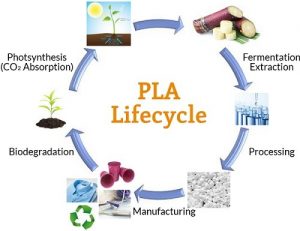
Polylactic Acid, also known as Polylactide (PLA) is a type of thermoplastic aliphatic polyester extracted from renewable resources such as corn starch (in the US – United States), tapioca roots, starch/chip (majorly in Asia), or sugarcane (in RoW – Rest of the World). In the year 1920, Wallace Corothes invented PLA who also discovered Nylon, though it was commercialized on a larger scale later. The chemical representation of polylactic acid is (C3H4O2) n. It is derived by condensing lactic acid by loss of water. It can also be extracted by ring-opening polymerization of lactide in presence of various metal catalysts. As illustrated below, the polylactides degrade into non-toxic products during the process of decomposition. Being biodegradable and biocompatible, it limits the plastic waste.
Related Project:- Polylactic Acid (PLA) Production
PLA is an effective substitute for petroleum-derived polymers because of its effective machinability and processability. It is the second-largest consumed bio-plastic across the globe. The polymer is hydrophobic with poor stiffness, prolonged degradation rate, less reactive side chain groups, and thermal stability. In relative to other bio-decomposable polyesters, PLA is one of the effective environment-friendly polymers considering its availability in abundance and cost-effectiveness. The polymer displays more crystallinity which can result in a higher melting point and brittleness. However, it can be mixed with other flexible polymers to reduce its brittleness and mechanical stiffness. It is generally amalgamated with starch to enhance its biodegradability and reduce cost. However, brittleness, high polarity, density, and fragile resistance to heat restrain the application of PLA.
PLA is largely used eco-friendly polymer and its decomposability is one of the unique selling points in the market. It has wide industrial applicability. The usages of Polylactic acid are mentioned below:
- FDA has approved PLA to be a safe polymer for use as food contact material. It is safe to use as a food packaging polymer for perishable products such as fruits and vegetables.
- The general packaging applications of polylactides comprises of salad/drinking cups, containers, blister and overwrap packages, and sundaes.
- The healthcare and medical sector are making effective usage of polylactides in products on biomedical implants that are bioabsorbable.
- Bio-based PLA’s are used in covers of spare wheels or translucent roof in hybrid vehicles.
- PLA is also used in manufacturing carpets, shirts, mattresses, bedding, and sportswear.
The highly-skilled NPCS team with a well-formulated plan assures higher returns. We offer all the necessary information required for the project.
GLOBAL MARKET TRENDS OF PLA
In the coming future, the PLA market shall exhibit promising opportunities in the bio-medical, packaging, agricultural, textile, and electronics sector. However, the ongoing recession on a global scale as a result of the Covid-19 pandemic could mark the decline of the PLA market in the year 2020. However, the PLA market is expected to revive and recover by the year 2021 and is expected to climb at 2348.1 million dollars by the year 2028. It is forecasted to grow at a compounded annual growth rate (CAGR) of 14.12% from the year 2019-2028. As illustrated below, North America has had a market monopoly contributing about 35.86 % of the total revenue in the year 2019. And the Asia Pacific market has been rapidly growing in terms of market volume and revenue.
Related Book:- The Complete Book on Biodegradable Plastics and Polymers (Recent Developments, Properties, Analysis, Materials & Processes)
The packaging sector is the largest end-user PLA market. While the contribution of corn starch as a raw material is maximum followed by sugar cane/sugar beet, cassava, and others as demonstrated below:
Some of the major global PLA brands are NatureWorksLLC, Mitsui Chemicals Inc, Hitachi Ltd., BASF SE, Corbion Purac BV, and Braskem.
INDIAN PLA MARKET
The PLA market of India is forecasted to grow at a 21.1 % CAGR during the periodic tenure of 2019-25. The PLA market segment of India appears promising because of the growing opportunities in the industrial sectors of packaging, textile, bio-medical, electronics, agriculture, and others. IBEF (India Brand Equity Foundation) points out that the Indian online food sector climbed to 150 % annually with a forecasted GMV (Gross Merchandise Value) of 300 million dollars in the year 2016. The contribution of the food processing sector to the Indian GDP was around 14 percent.
Related Video:- Polylactic Acid (PLA) Production
As the Indian food industry is augmenting, it is approximated to boost the market demand of PLA for packaging. Thus, generating potential opportunities for the same in the future. Also, the rising production of automotives and household appliances from several nations of Asia Pacifica such as Malaysia, Vietnam, Singapore, and India has led to the demand for the PLA market.
The PLA merchandise has an expansive demand across the globe and would be a productive business opportunity!
NPCS is one of the established brands in the industrial world providing technical consulting. Having researched the market for ‘Polylactic Acid, manufacturing of the same would generate higher revenues!
Pr.Pet_Art20